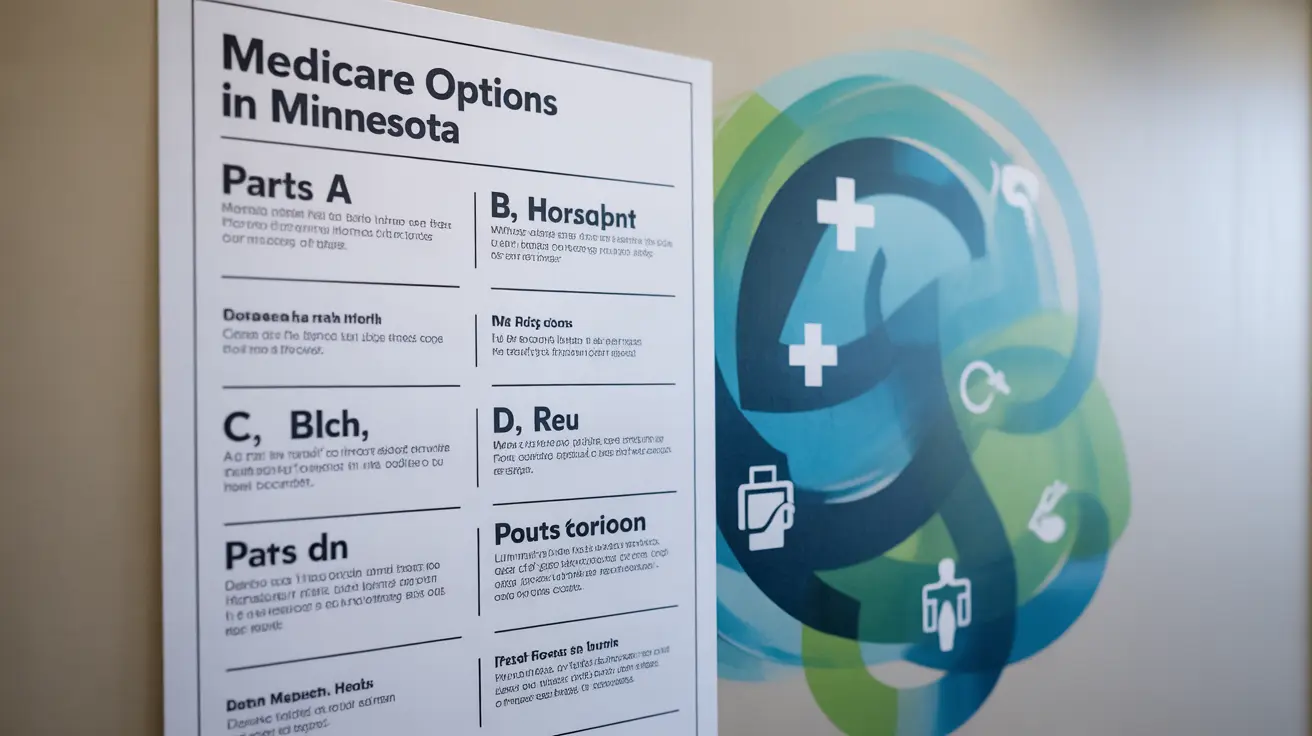Minnesota residents approaching Medicare eligibility face important decisions about their healthcare coverage. Understanding the various Minnesota Medicare plans available can help ensure you select the most appropriate option for your healthcare needs and budget. The state offers unique features and additional protections that distinguish it from other states' Medicare landscapes.
Navigating Medicare options requires careful consideration of factors including prescription drug coverage, provider networks, costs, and special state-specific programs. This comprehensive guide will help you understand your choices and make informed decisions about Medicare coverage in Minnesota.
Understanding Medicare Basics in Minnesota
Medicare consists of several parts that work together to provide comprehensive healthcare coverage. Part A covers hospital insurance, while Part B provides medical insurance for doctor visits and outpatient services. Part C, known as Medicare Advantage, offers an alternative way to receive Medicare benefits through private insurance companies. Part D provides prescription drug coverage.
Minnesota participates in all standard Medicare programs while offering additional state-specific options and consumer protections. The state's regulatory environment provides extra safeguards for beneficiaries, including enhanced oversight of insurance companies and additional appeal rights.
Original Medicare vs. Medicare Advantage in Minnesota
Original Medicare (Parts A and B) operates the same way throughout the United States, including Minnesota. This traditional fee-for-service program allows you to see any doctor or specialist who accepts Medicare without needing referrals. You can supplement Original Medicare with a separate Part D prescription drug plan and a Medigap policy for additional coverage.
Medicare Advantage plans in Minnesota are offered by private insurance companies approved by Medicare. These plans often include prescription drug coverage and may offer additional benefits such as dental, vision, or wellness programs. However, they typically require you to use a specific network of healthcare providers and may require referrals to see specialists.
Minnesota's Unique Medigap Landscape
Minnesota operates under different Medigap regulations compared to most other states. While most states follow standardized Medigap plans (labeled A through N), Minnesota has its own system with different plan types and naming conventions. This creates both opportunities and complexities for Minnesota residents shopping for supplemental coverage.
The state offers basic and extended basic plans, along with various add-on options. Minnesota's regulatory framework provides certain consumer protections, including guaranteed renewable policies and standardized benefits within each plan type. Understanding these state-specific features is crucial when comparing Medigap options.
Minnesota Medigap Plan Features
Minnesota Medigap plans include basic coverage that typically covers Medicare Part A coinsurance, Part B coinsurance up to certain limits, and the first three pints of blood. Extended basic plans offer more comprehensive coverage, including higher Part B coinsurance limits and additional benefits.
The state allows various riders and add-ons that can enhance your coverage, such as prescription drug coverage (though Part D plans are often more comprehensive), additional Part B coverage, and foreign travel emergency coverage. These options provide flexibility to customize your coverage based on your specific needs.
Medicare Advantage Options in Minnesota
Medicare Advantage enrollment in Minnesota has grown significantly in recent years, with numerous plans available across different counties. Major insurers offering Medicare Advantage plans in the state include Humana, Blue Cross Blue Shield of Minnesota, Medica, and UnitedHealthcare, among others.
When evaluating Medicare Advantage plans for 2026, consider factors such as monthly premiums, deductibles, out-of-pocket maximums, and prescription drug coverage. Many plans offer $0 monthly premiums, but it's important to look beyond the premium to understand total potential costs.
Comparing Plan Networks and Benefits
Medicare Advantage plan networks vary significantly, so verify that your preferred doctors and hospitals participate in any plan you're considering. Some plans may offer broader networks, while others focus on specific health systems or regions within Minnesota.
Additional benefits often included in Medicare Advantage plans may encompass dental coverage, vision care, hearing aids, transportation to medical appointments, and wellness programs. These extras can provide significant value but should be weighed against potential limitations in provider choice and geographic coverage.
Enrollment Periods and Deadlines
Several enrollment periods allow Minnesota residents to make changes to their Medicare coverage. The Initial Enrollment Period occurs around your 65th birthday, spanning seven months total. The Annual Open Enrollment Period runs from October 15 through December 7 each year, allowing changes to Medicare Advantage and Part D plans.
Special Enrollment Periods may apply in certain circumstances, such as moving to a new area, losing employer coverage, or qualifying for Extra Help with prescription drug costs. Minnesota residents may also have additional enrollment opportunities due to state-specific regulations.
Missing enrollment deadlines can result in coverage gaps or late enrollment penalties, making it crucial to understand and track relevant dates. Planning ahead and gathering necessary information well before deadlines helps ensure smooth transitions between coverage options.
Choosing the Right Plan for Your Needs
Selecting appropriate Medicare coverage requires careful analysis of your healthcare needs, budget, and preferences. Start by evaluating your current health status, regular medications, preferred doctors and hospitals, and anticipated medical expenses. This assessment helps narrow down options that align with your specific situation.
Consider both current and future healthcare needs when making your decision. While you can generally change Medicare Advantage and Part D plans annually, Medigap enrollment opportunities may be more limited after your initial eligibility period.
Cost Comparison Strategies
Comparing total costs across different plan options requires looking beyond monthly premiums to include deductibles, copayments, coinsurance, and out-of-pocket maximums. Use Medicare's online Plan Finder tool or work with a licensed insurance agent to get personalized cost estimates based on your specific medications and healthcare usage patterns.
Factor in potential costs for services you use regularly, such as specialist visits, diagnostic tests, or ongoing treatments. Plans with lower premiums may have higher out-of-pocket costs, while plans with higher premiums might offer more predictable expenses.
Frequently Asked Questions
What are the different types of Medicare plans available in Minnesota?
Minnesota offers Original Medicare (Parts A and B), Medicare Advantage plans (Part C), standalone Part D prescription drug plans, and state-specific Medigap supplemental insurance plans. Minnesota's Medigap plans follow different rules than the standardized plans available in most other states, offering basic and extended basic options with various add-on coverage choices.
How do Minnesota Medigap plans differ from those in other states?
Minnesota operates under unique Medigap regulations instead of following the standardized plans (A through N) used in most states. Minnesota offers basic and extended basic plans with customizable add-on options. The state provides certain consumer protections and has different plan structures, naming conventions, and benefit packages compared to standardized Medigap plans elsewhere.
What are the best Medicare Advantage plans in Minnesota for 2026?
The best Medicare Advantage plans vary based on individual needs, location, and preferences. Top-rated plans in Minnesota typically come from insurers like Humana, Blue Cross Blue Shield of Minnesota, Medica, and UnitedHealthcare. Consider factors such as provider networks, prescription drug coverage, additional benefits, costs, and customer satisfaction ratings when evaluating options for your specific situation.
How do I compare Medicare plans and choose the right one for my needs in Minnesota?
Compare plans by evaluating your healthcare needs, preferred doctors and hospitals, current medications, and budget. Use Medicare's Plan Finder tool online, review plan summaries and provider directories, and calculate total potential costs including premiums, deductibles, and out-of-pocket expenses. Consider working with a licensed insurance agent or attending local Medicare education events for personalized guidance.
What are the enrollment deadlines and periods for Minnesota Medicare plans?
Key enrollment periods include the Initial Enrollment Period (7 months around your 65th birthday), Annual Open Enrollment (October 15 - December 7), and various Special Enrollment Periods for qualifying life events. Minnesota residents have the same federal enrollment periods as other states, with potential additional opportunities due to state-specific regulations. Missing deadlines may result in penalties or limited enrollment options.




